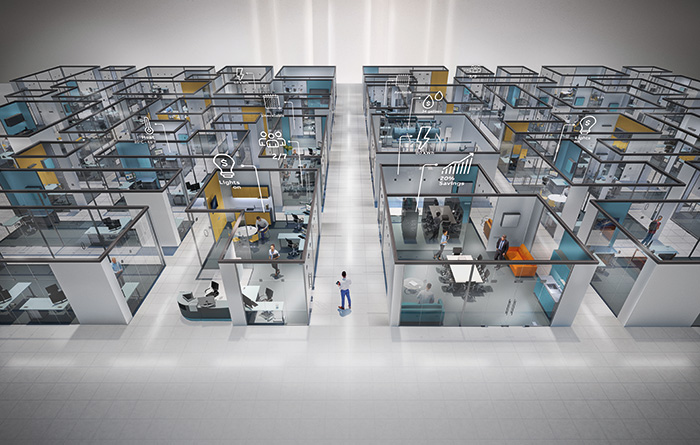Considerations For Cutting Costs And Emissions With Smart Building Technology

Buildings consume more than 30 percent of the world’s energy and produce almost 40 percent of global carbon emissions. This highlights the importance of enhancing their energy efficiency, for example by using smart building technology.
These technologies aren’t new; they have been used by facilities managers for decades as a means of control, but cost is often viewed as an obstacle.
However, the right technology reduces running costs. Intelligent investment in technology maximises overall returns. Here are several important considerations:
Implement Metering And Monitoring
It’s important that facility managers know exactly where and how energy is being used in their building. Being able to pinpoint the most energy-consuming appliances in a facility helps understand areas of inefficiency. A strategy can them be implemented to optimise energy use, improve efficiency and save costs. After all, if you can’t measure it then you can’t manage it, and if you can’t manage it then you can’t improve it.
Understanding and implementing the correct metering strategy also enables a proactive approach to maintenance. Systems can provide alerts to unusually high energy readings or continuous spikes of current, which can help prevent breakdowns and increase the lifespan of equipment.
Monitoring doesn’t just have to cover energy use though. You can also measure air quality, temperature and even lighting conditions. Correct monitoring of these parameters ensures occupant comfort and wellbeing.
Employ Intelligent Building Automation And Smart BMS

A building management system (BMS) operating alongside a building automation system enables facilities managers to program functions like HVAC, lights and blinds. Traditionally, these can be programmed to turn on and off at specific times.
A smart BMS takes this one step further and finds ways to save energy in real-time. It can adjust systems automatically using regular input from sensors. For example, it knows to switch off HVAC and lights when rooms are empty. You can even connect it to external temperature sensors or online forecasts to proactively adjust settings with the weather – minimising energy use without reducing occupant comfort.
HVAC and lighting alone can account for about 50 percent of energy use in an average commercial building. By incorporating smart automation, managers may see decreased energy costs of 30 to 50 percent.
Smart BMS systems can connect to cloud services to remotely alert facilities managers of high usage. They also enable real time performance monitoring from anywhere in the world, so multiple sites can be visualised and compared.
Use Open Protocol Communication
Using open communication protocols, like KNX and BACnet, ensures a cohesive and interconnected ecosystem within a building. This is where devices from various manufacturers all speak the same language, making it a vital element of smart building development. Having tech that seamlessly communicates with each other ensures faster and easier integration by minimising connectivity and installation issues.
This also means you are not tied down to sourcing smart building technologies from one company or system. This helps facility managers looking to stay ahead of an ever-changing environment – both in terms of the latest technology and government regulations.
Achieving Certifications
Implementing smart building technologies also contributes to achieving sustainable building certifications, such as BREEAM or NABERS rating schemes. This can have a big impact on rental income for building owners as well as business success for occupants.
Research by the US Green Buildings Council (USGBC), the developers of the LEED certification scheme, found that that 79 percent of those working in a LEED-certified building say they would choose another job in a LEED-certified building over a non-LEED building. Workers in LEED-certified green buildings also reported feeling happier, healthier and more productive.
As an example, Manchester Metropolitan University’s Faculty of Arts and Humanities Building recently installed a smart BMS. This provides automated control as well as 24/7 web browser access to alarms, trends and scheduling for temperature, lighting and air quality.
The system produces significant energy savings as part of the University’s strategy to cut emissions by 44 percent by 2026. With the help of the smart BMS, the building has been certified as “excellent” under the UK’s BREEAM certification. The University uses the certification as a means of attracting more students because, according to a 2021 survey by Times Higher Education, a university’s sustainability is more important than location for prospective international students.
Looking Ahead…

With the rise of ESG (environmental, social and corporate governance), companies are under increasing pressure to reduce energy consumption and use renewable energy sources in their buildings. This is especially true for larger businesses needing to comply with the UK’s ESOS regulations (Energy Savings Opportunity Scheme). The methods mentioned above are crucial steps for facilities managers looking to achieve energy efficient buildings.
The past year has also seen growing interest in artificial intelligence (AI) in the smart buildings market, with rising opportunities to create buildings that operate efficiently with minimum human intervention.
Another noteworthy trend is the repurposing of existing buildings, like with the Edinburgh example above. Smart solutions can be implemented when retrofitting residential and industrial structures to optimise energy usage. Data from the European Parliament suggests that, via deep renovation, older buildings can potentially reduce heating demand by more than 70 percent.
Adoption of smart technology is key to boosting a building’s energy efficiency and sustainability. By controlling, analysing and optimising building systems, facilities managers can meet sustainability targets while also cutting costs and providing a good experience for the people using the building every day.
Click the article to enlarge it.



























































